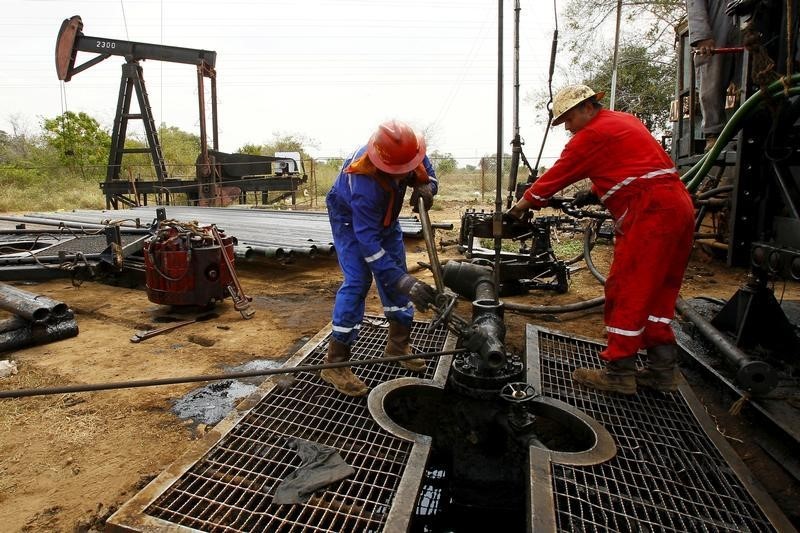TOKYO, July 16 (Reuters) - Oil prices fell for a second day
on Tuesday as more production facilities returned to operation
in the U.S. Gulf after Hurricane Barry swept through over the
weekend, while Chinese economic data dimmed the outlook for
crude demand.
Brent crude futures LCOc1 were down 10 cents, or 0.2%, at
$66.38 a barrel by 0028 GMT. They fell 0.4% overnight.
U.S. crude CLc1 fell by 10 cents, or 0.2% to $59.48 a
barrel. The U.S. benchmark fell about 1% in the previous
session.
Both contracts last week made their biggest weekly gains in
three weeks as U.S. oil inventories fell and diplomatic tensions
rose in the Middle East.
But as producers on Monday began restoring some of the
nearly 74% of output that was shut at U.S. Gulf of Mexico
platforms ahead of Hurricane Barry, concerns about oversupply
returned to the fore.
And while Chinese data on Monday showed industrial output
and retail data beat expectations, overall figures showed the
country's slowest quarterly economic growth in decades.
China's oil throughput rose to a record 13.07 million
barrels per day in June, up 7.7% from a year earlier, following
the start-up of two new large refineries, official data showed.
Still, economic growth of just 6.2% in the second quarter of
2019 - the weakest in 27 years - highlighted the impact of trade
tensions with Washington and raised the possibility that more
incentives might be needed to jump-start the economy.
"The more significant drag on oil markets is China's weaker
consumption data," said Stephen Innes, managing partner, at
Vanguard Markets.
In the U.S. there was 1.3 million barrels per day (bpd) of
oil production offline in the U.S.-regulated areas of the Gulf
of Mexico on Monday, about 80,000 barrels fewer than on Sunday.
Workers also were returning to the more than 280 production
platforms that had been evacuated. It can take several days for
full production to be resumed after a storm leaves the Gulf of
Mexico.
- English (USA)
- English (UK)
- English (India)
- English (Canada)
- English (Australia)
- English (South Africa)
- English (Philippines)
- Deutsch
- Español (España)
- Español (México)
- Français
- Italiano
- Nederlands
- Português (Portugal)
- Polski
- Português (Brasil)
- Русский
- Türkçe
- العربية
- Ελληνικά
- Svenska
- Suomi
- עברית
- 日本語
- 한국어
- 简体中文
- 繁體中文
- Bahasa Indonesia
- Bahasa Melayu
- ไทย
- Tiếng Việt
- हिंदी
Oil down for a second day as U.S Gulf of Mexico output returns
Published 16/07/2019, 01:45
Oil down for a second day as U.S Gulf of Mexico output returns

Latest comments
Install Our App
Risk Disclosure: Trading in financial instruments and/or cryptocurrencies involves high risks including the risk of losing some, or all, of your investment amount, and may not be suitable for all investors. Prices of cryptocurrencies are extremely volatile and may be affected by external factors such as financial, regulatory or political events. Trading on margin increases the financial risks.
Before deciding to trade in financial instrument or cryptocurrencies you should be fully informed of the risks and costs associated with trading the financial markets, carefully consider your investment objectives, level of experience, and risk appetite, and seek professional advice where needed.
Fusion Media would like to remind you that the data contained in this website is not necessarily real-time nor accurate. The data and prices on the website are not necessarily provided by any market or exchange, but may be provided by market makers, and so prices may not be accurate and may differ from the actual price at any given market, meaning prices are indicative and not appropriate for trading purposes. Fusion Media and any provider of the data contained in this website will not accept liability for any loss or damage as a result of your trading, or your reliance on the information contained within this website.
It is prohibited to use, store, reproduce, display, modify, transmit or distribute the data contained in this website without the explicit prior written permission of Fusion Media and/or the data provider. All intellectual property rights are reserved by the providers and/or the exchange providing the data contained in this website.
Fusion Media may be compensated by the advertisers that appear on the website, based on your interaction with the advertisements or advertisers
Before deciding to trade in financial instrument or cryptocurrencies you should be fully informed of the risks and costs associated with trading the financial markets, carefully consider your investment objectives, level of experience, and risk appetite, and seek professional advice where needed.
Fusion Media would like to remind you that the data contained in this website is not necessarily real-time nor accurate. The data and prices on the website are not necessarily provided by any market or exchange, but may be provided by market makers, and so prices may not be accurate and may differ from the actual price at any given market, meaning prices are indicative and not appropriate for trading purposes. Fusion Media and any provider of the data contained in this website will not accept liability for any loss or damage as a result of your trading, or your reliance on the information contained within this website.
It is prohibited to use, store, reproduce, display, modify, transmit or distribute the data contained in this website without the explicit prior written permission of Fusion Media and/or the data provider. All intellectual property rights are reserved by the providers and/or the exchange providing the data contained in this website.
Fusion Media may be compensated by the advertisers that appear on the website, based on your interaction with the advertisements or advertisers
© 2007-2025 - Fusion Media Limited. All Rights Reserved.